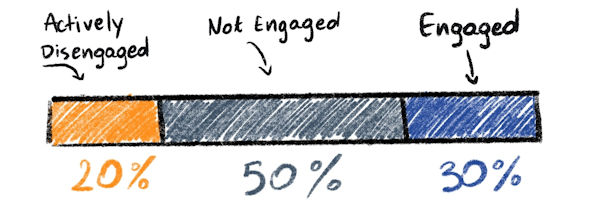Why are your employees not engaged?
Are your employees more busy gossiping than working? Is your sales team not approaching your customers? Are your Help Desk employees leaving the company after a few months? If these are your company's problems, know that you are not alone. Annual research conducted by Gallup (collected in the State of the American Workplace report) shows that in the United States less than a third of employees are actively engaged in their work. And this is not a temporary result of the economic downturn, but a constant problem. During the 15 years of research (between 2001 and 2016), the percentage of engaged employees ranged between 28 and 33. At the same time, employees who were actively disengaged constituted 15-20 percent of the entire study group (the remaining 50% consist of not engaged employees). Of course, this is not just a problem for US companies.

I don't even have to explain that your employees’ disengagement affects the effectiveness of the whole company. Starting from lower quality of services or products through higher employee turnover and ending with lower financial results.
Where does the lack of engagement come from?
The Intercity train I had recently traveled with to Warsaw had a long delay. Travelers, trying to change trains in the capital, went to look for the conductor to tell him to "do something about it" and express their dissatisfaction. Personally, I am not surprised; I myself had a lot to say when LOT canceled my connection last year, which caused me to arrive with a 27 hour delay. In such situations, frustration ensues and the passengers go most often to pour their grievances to the nearest company representative - a conductor, a flight attendant or a customer service representative. Of course, this "first line" does not have any control over the event as a whole as the delays result from how the whole company works: how the connection network was planned, what other duties employees may have, what the relationships between various elements inside and outside the company are, how the whole system is resistant to such situations, and finally, how all departments work together when a delay occurs. Similarly, in your company, employees do not have full control over what is happening - they are dependent on other people, limited by processes, and lack knowledge and the right to make decisions. Despite this, when something bad happens, people who have direct contact with the client will take on the whole blow of fury and grudge.
If these situations are rare, then employees will apologize sincerely and try to compensate the passengers for any inconvenience caused. A great example is Japan Rails where management officially apologized to their customers when one of their trains departed 20 seconds too early. However, when this situation is commonplace, your employees have two options. If you are lucky, they will try to do something about the problems they are observing. They will address them with their supervisors and suggest solutions. You can then use the potential of your employees to improve the company's effectiveness. The customers, employees, you and the whole company will benefit. However, if you ignore the reported problems, then your employees might try for the second or even third time. Finally, after bouncing off the glass ceiling a few times, they will finally give up and go looking for a job elsewhere. Therefore, the first consequence of poor services and products is that you willlose good, motivated people.
The second and worst possibility is that your employees will decide that "this is how it should be." They will no longer try to change the system and accept that they have to deal with angry customers on a regular basis. Because their problems are common, everyday life, which they cannot change, your employees will not feel the need to help and even be reluctant to do so. Instead, they will stick to their responsibilities and procedures and wait until the end of the shift to go home and vent about their hard day. Therefore, the second consequence of poor service is that you will retain weaker, unmotivated employees.
Are your employees proud of what they do?
It is time to admit that the lack of employee engagement usually results not from the fact that "they do not want to," but from the fact that "they cannot." If the delivered product or service consistently does not meet the client's expectations, and the imposed procedures prevent good service, most employees turn into zombies who "only do their work." It is the company that does not allow them to work in a way that they would be proud of. Therefore, it is primarily up to you and other managers to enable them. To achieve this, you must do three things.
1. Create product for the user, not the stakeholders
First, focus your products on the users. In the case of most services, unhappy customers have no problem finding out that someone else provides a better service and quickly change their provider. Google, for over a decade, has over 80% share in the search engine market because it gives its users what they need - high-quality answers in a short time. And at the same time, it minimizes things that can irritate their audience, for example, huge pop-up ads. Another example is Revolut, a company that has gained 4 million customers in four years, giving them an easy and cheap solution to paying in different currencies - something that no bank has yet offered. As long as your product is focused on the internal stakeholders, it is not surprising that your clients will leave for your competitors who can provide them with better quality.
2. Empower your employees
Secondly, give your employees (especially those who have contact with your clients) all the information, tools and resources they need. Processes should be tailored to frontline employees, not the other way around. At Toyota, any assembly line worker has the right to stop a production line if they suspect that a quality problem may occur. Although a minute of downtime costs hundreds of thousands of dollars, this approach guarantees that the line stops much less frequently than in other companies. Another example is Zappos, where a customer support employee may decide to send a new pair of shoes without asking his supervisor. Despite this "lack of cost control," the company is far from bankrupt and is still growing and employing over 1,500 people. The last example is SouthWest, an airline where employees are asked to "express themselves." Some do it by telling jokes, some by singing, some by playing the guitar - and always with a smile. The management does not force anyone to such behavior, and the result is satisfied customers, one of the lowest employee turnover rates in the industry, and uninterrupted profits for 44 years.
3. Ensure that all employees are in contact with the user
The third element necessary to create an environment that employees are proud of is to push everyone in the company to know their customers. Not only "first line" employees must have daily contact with users of your products and services. Also developers, testers, analysts, marketing, sales and all management must understand what makes your customers’ lives easier. There are many techniques, from User Story to Persona, but the most important is direct face-to-face contact. Since this is a broad topic, I invite you to read a separate article about three ways to understand your users.
Building engagement is a strategic decision
Of course, it takes time to implement these changes. Especially if you haven't listened to your employees' voices for the past five years, don't be surprised if they are distrustful when you ask them what you can do to improve your services and products. However, the alternative is not to change anything. Which is not a problem if you have a monopoly like PKP or LOT in Poland, or other companies "too big to fail." Yet, in most cases, no change will result in the loss of the best employees and customers leaving to the competition. It’s time to get to work. Let your employees be proud of what they do.

